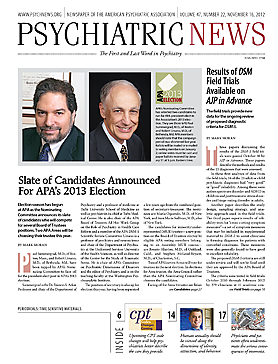Edward Pontius, M.D., serves on the APA Committee on Electronic Health Records and in the Assembly. He has previously served on the Certification Commission on Health Information Technology’s Behavioral Health Work Group. This column describes his patient-centered approach to engaging patients with their own health information in a manner that prevents the technology from becoming a barrier between patients and psychiatrists.
—Steven Daviss, M.D.
For the past seven years, I’ve been doing my routine outpatient psychiatric care in offices equipped with video projection. Patients and caregivers sit beside me, sharing with me a great view of my computer screen projected across 12 square feet of the office wall across from us.
We do concurrent documentation—I explain to patients that our work together involves creating the assessment, the progress notes, the treatment plans, and prescriptions. “None of this is supposed to be a secret kept from you. Please tell me if there’s anything you see that doesn’t seem right or you don’t understand.”
While psychiatric practice has always been a collaboration between psychiatrist and patient, the documentation of the experience generally was a private activity. Patients generally did not participate in the creation of documents describing them and their treatment. As patients have increasingly begun reading their medical records, they have increasingly had questions and at times have taken serious issue with what they’ve found.
How is this shared documentation different from traditional documentation?
• Accuracy: When we create the document in isolation, mistakes go unrecognized and can lead to difficulties, even putting patients at risk. As the glowing letters grow on the display wall, my patients let me know immediately when I’ve got it wrong. “Doc, no, I had that postpartum depression after my second child.” When I’m paraphrasing or shortening a patient’s lengthy description of a stressor, I will generally type up a short phrase and ask my patient, “Did I get that about right?”
• Trust: One of the major advantages with collaborative video documentation is that patients have immediate evidence that they are being heard. Although many of my patients have had significant issues with trust, collaborative video documentation seems to promote trust from the first session. This is in clear contrast to in-session documentation with laptops or PC monitors. Concurrent documentation can involve periods of loss of eye contact that tend to reduce engagement and trust. However patients watching you interact with the EHR and putting text on the wall experience you as being involved in a shared activity for their benefit. Patients looking at the lid of your laptop or the back of your PC monitor can only wonder what you are doing.
Doing documentation together does not mean that the patient and I are always in agreement. On occasion I’m including not only my assessment, but also recording the patient’s dissenting point of view. “ ‘Patient notes the doctor believes the lithium must be taken daily to prevent future manic episodes, and the patient thinks he can take it intermittently and safely manage that fine line between performance-enhancing hypomania and full-blown mania.’ Does that sum our view up pretty well?”
Although this may seem like a daunting challenge at first, this practice of no-surprises documentation has held up with the range of adult psychiatric patients encountered in outpatient practice, including patients with psychotic disorders, substance use disorders, patients functioning well in the community, and patients in need of ACT-level care. Our experience suggests that no-surprises documentation reduces the likelihood of patients later filing grievances about their care or documentation.
• Effectiveness: There is a lot of information to be reviewed with patients. There are times when the fastest and most reliable means to review information together is to do so visually. I can often accomplish medication reconciliation faster and more reliably presenting a screen that lists my most recent prescription data for the patient and asking, ”Has any of this changed?” We can create a shared treatment plan together that is all the more real for the patient because it is also appreciated visually.
• Patient Satisfaction: Patients frequently remark that they like being able to work on documentation together and indicate that they would appreciate the opportunity to do this with their other providers.
Special Challenges
While this approach has the above strengths, it is not without challenges. Current EHR software is not optimized to protect confidentiality of patient data during joint viewing from log on to log off. Care must be taken to not show other patient information. Because many current projectors use high-intensity lamps that can take 10 seconds to cycle off, it’s useful to have a quick and easy way of interrupting the projection while navigating—an oversize sticky note can be quickly moved in front of the projector to accomplish this.
Room lighting must be considered, as well as a projection surface or large LCD monitor. A mobile typing table for the laptop or keyboard is useful, as well as an additional small table for patients or case managers to help them manage their own paperwork and technology.

Edward Pontius, M.D., does outpatient and telepsychiatry practice, clinical teaching, and program development in Brunswick, Maine. Steven Daviss, M.D., is chair of the APA Committee on Electronic Health Records, an Assembly representative for Maryland, a member of the Health Standards Committee at URAC, and a HIE Policy Board member at the Maryland Health Care Commission. He is also a clinical assistant professor at the University of Maryland, chair of the Department of Psychiatry at Baltimore Washington Medical Center, and coauthor of the book Shrink Rap: Three Psychiatrists Explain Their Work. Dr. Daviss tweets at @hitshrink and blogs at http://hitshrink.blogspot.com/ .

